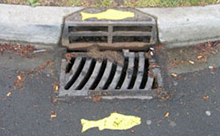Managing Stormwater
With increasing urbanization, there are more impervious surfaces (roads, parking lots, sidewalks and roofs), which prevent rainwater from passing into the soil. This results in much higher surface runoff, known as “stormwater”. When rainwater travels over roads, parking lots and properties, it can pick up chemicals, metals, dirt and oils which get carried into the stormwater system, which are connected to our creeks, streams and shorelines. Higher stormwater levels can impact local business, animals and the environment through flooding, erosion, pollution and habitat degradation.

With a changing climate, the region is expected to see more intense rainfall events in the winter months. It is becoming increasing more important to properly manage stormwater to reduce peak flows and flooding events.
What Can I Do as a Business Owner or Operator?
Industrial, commercial and institutional (ICI) facility operators have an important role in managing stormwater. By adhering to applicable regulations and adopting best management practices, stormwater contaminants can be significantly reduced protecting your business and the environment.